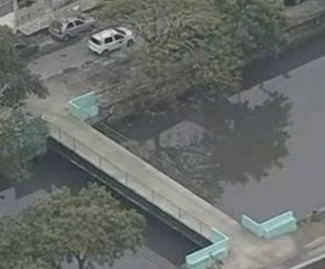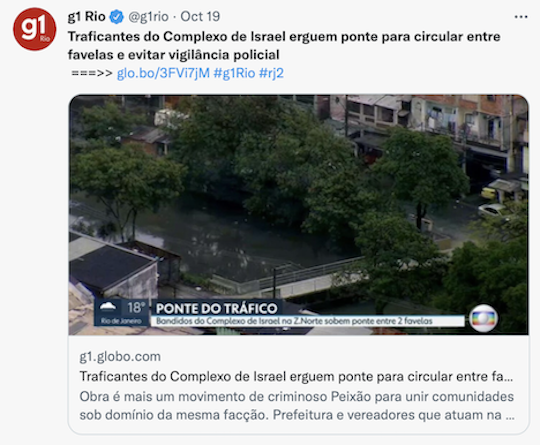Third Generation Gangs Strategic Note No. 44: Peixão Facção Builds a Canal Bridge to Elude Police and Consolidate Criminal Governance
John P. Sullivan, José de Arimatéia da Cruz, and Robert J. Bunker
The drug trafficking faction (facção) in the “Complexo de Israel” (Israel Complex) led by Álvaro Malaquias Santa Rosa, known as Peixão (Big Fish) built a bridge over a canal in Rio de Janeiro’s Zona Norte (North Zone) to elude police surveillance. The bridge connects the Favela das Cinco Bocas, in Brás de Pina, to Cidade Alta, in Cordovil.

Ponte construída por traficantes no Complexo de Israel (Bridge built by traffickers in Complexio de Israel). Source: “Traficantes do RJ constroem Ponte que ajudam moradores de Vigário, Parada de Lucas e Brás de Pina.” YouTube, 1 November 2021, https://youtu.be/pBCasDY1O1U.
Key Information: “RJ: Traficantes erguem ponte entre favelas para evitar vigilância policial.” ISTOÉ. 20 October 2021, https://istoe.com.br/rj-traficantes-erguem-ponte-entre-favelas-para-evitar-vigilancia-policial/:
Traficantes do Rio de Janeiro construíram uma ponte para ligar duas comunidades, as favelas Cinco Bocas e Pica-pau, na Zona Norte.
Oficialmente a obra não teve dinheiro público nem interferência de políticos. A suspeita da polícia é que foi um projeto do traficante conhecido como Peixão, de 34 anos, para unir cinco comunidades e fortalecer a região chamada de Complexo de Israel.[1]
Key Information: “Traficantes do Complexo de Israel erguem ponte para circular entre favelas e evitar vigilância policial.” TV Prefeito. 20 October 2021, https://tvprefeito.com/traficantes-do-complexo-de-israel-erguem-ponte-para-circular-entre-favelas-e-evitar-vigilancia-policial/:
Traficantes do Complexo de Israel, na Zona Norte do Rio, construíram uma ponte para ligar duas comunidades antes rivais: as favelas Cinco Bocas, em Brás de Pina, e Pica-pau, em Cordovil.
A obra na Avenida Schultz Wenk, sobre o Rio Irajá, não usou dinheiro público. Não teve participação da Prefeitura do Rio e nem indicação de vereadores da Câmara Municipal.
No local, a polícia investiga a ação do traficante Álvaro Malaquias Santa Rosa, conhecido como Peixão, de 34 anos, para unir cinco comunidades: Cinco Bocas, Pica-pau, Cidade Alta, Vigário Geral e Parada de Lucas. A ideia é transformar no que já vem sendo chamado entre moradores de Complexo de Israel.
Segundo as investigações, a tomada dos territórios foi feita durante a pandemia, aproveitando o período de isolamento e de poucas incursões da polícia.[2]
Key Information: Marco Antônio Martins and Lilia Teles, “Traficantes do Complexo de Israel erguem ponte para circular entre favelas e evitar vigilância policial.” G1 (Globo). 19 October 2021, https://g1.globo.com/rj/rio-de-janeiro/noticia/2021/10/19/ponte-trafico-complexo-de-israel.ghtml:
A ponte para a passagem de carro é a obra mais recente desta ação. Antes de Peixão, Cinco Bocas e Pica-pau era dominadas por facções rivais de traficantes. O problema era amenizado por não haver uma passagem de veículos ligando as duas favelas.
Antes da ponte para se chegar a um dos lados era necessário seguir até a Avenida Brasil ou na direção contrária até a rua Jorge Coelho, próximo à estação de trem. Agora, é diferente.
Imagens do Globocop mostram que a ponte liga direto Cinco Bocas e Pica-pau. Segundo moradores, assim os traficantes da quadrilha de Peixão não se expõe de ir até a Avenida Brasil…
Complexo de Israel
O Globocop mostra ainda a dimensão do Complexo de Israel, que se expande às margens da Avenida Brasil.
Em cada uma das favelas do complexo, os criminosos exibem símbolos do Estado de Israel, como a bandeira do país e a estrela de Davi, instalados em pontos altos das comunidades.
Há um ano, o RJ2 mostrou a expansão do novo complexo de favelas, onde moram 134 mil pessoas.[3][4]
Third Generation Gangs Analysis
The facção (drug trafficking faction) in the Complexo de Israel led by Álvaro Malaquias Santa Rosa, known as Pexâo, reportedly built a bridge across a canal along Avenida Schultz Wenk in the Zona Norte do Rio (Rio’s North Zone) to facilitate pedestrian and motorcycle traffic and avoid police surveillance. According to multiple press reports, no public funds or government participation were used to build the bridge.[5] The bridge links five communities: Cinco Bocas, Pica-pau, Cidade Alta, Vigário Geral, and Parada de Lucas. Collectively, these favelas are being consolidated into the Complexo de Israel. The area has a combined population of around 135,000 residents.[6] The Peixão facção (Peixão faction) is involved in a gang war between the Comando Vermelho (CV) and Terceiro Comando Puro (TCP). It has previously been reported that Peixão, a TCP leader, is funding a dissident milícia (militia) wing in Itaboraí. In addition, it is believed that the TCP seeks to expand links with militiamen in São Gonçalo to counter CV influence.[7]
The ability of a drug trafficking faction to build a bridge across a canal within Rio de Janeiro to facilitate mobility and elude the police clearly demonstrates territorial control over the Complexo de Isreal and sophisticated operations by the Peixão facção. The bridge was apparently built using materials diverted from a local construction project.[8]. This potentially involves collusion with the construction company and its workers, as well as potential corruption and extortion to enable construction of the bridge. The bridge also provides the gang the benefit of exploiting its ‘interior lines’ for shifting gunmen and other resources to respond to threats as needed. Further, it can also be viewed by the populace under its control as a tangible ‘public good’ provided by the gang to better allow the local communities to interact with one another. Here we see a quadrilha (gang) demonstrate distinct third generation characteristics in its pursuit of territorial control and consolidation of power in its favela complex.[9]

Ponte do Tráfico (Trafficking Bridge). Source: G1 Rio, “Traficantes do Complexo de Israel erguem ponte para circular entre favelas e evitar vigilância policial.” Twitter. 19 October 2021, https://twitter.com/g1rio/status/1450590979455586311?s=20.
Sources
Marco Antônio Martins and Lilia Teles, “Traficantes do Complexo de Israel erguem ponte para circular entre favelas e evitar vigilância policial.” G1 (Globo). 19 October 2021, https://g1.globo.com/rj/rio-de-janeiro/noticia/2021/10/19/ponte-trafico-complexo-de-israel.ghtml.
“RJ: Traficantes erguem ponte entre favelas para evitar vigilância policial.” ISTOÉ. 20 October 2021, https://istoe.com.br/rj-traficantes-erguem-ponte-entre-favelas-para-evitar-vigilancia-policial/.
“Traficantes constroem ponte para facilitar trânsito e evitar vigilância policial.” Portal Tucumã. 20 October 2021, https://www.portaltucuma.com.br/traficantes-constroem-ponte-para-facilitar-transito-e-evitar-vigilancia-policial/.
“Traficantes do Complexo de Israel erguem ponte para circular entre favelas e evitar vigilância policial.” TV Prefeito. 20 October 2021, https://tvprefeito.com/traficantes-do-complexo-de-israel-erguem-ponte-para-circular-entre-favelas-e-evitar-vigilancia-policial/.
Endnotes
[1] In English, the title reads: “RJ: Traffickers build bridge between favelas to avoid police surveillance.” The text reads: “Traffickers in Rio de Janeiro have built a bridge to connect two communities, the Cinco Bocas and Pica-pau favelas in the North Zone. […] Officially the bridge had no public money or political interference. Police suspect that it was a project of the 34 year old drug trafficker known as Peixão to unite five communities and strengthen the region called Complexo de Israel.”
[2] In English, the title reads: “Traffickers from Complexo de Israel build bridge to circulate between favelas and avoid police surveillance.” The text reads: “Traffickers from Complexo de Israel, in Rio’s North Zone, built a bridge to connect two formerly rival communities: the favelas Cinco Bocas, in Brás de Pina, and Pica-pau, in Cordovil. […] The work on Avenida Schultz Wenk, over the Irajá River, did not use public money. There was no participation of the Rio City Hall, and no indication of [participation by] City Councilmen. […] At the site, the police are investigating the action of the drug dealer Álvaro Malaquias Santa Rosa, known as Peixão, 34, to unite five communities: Cinco Bocas, Pica-pau, Cidade Alta, Vigário Geral, and Parada de Lucas. The idea is to transform them into what is already being called, among residents, the Complexo de Israel. […] According to investigations, the territories were taken over during the pandemic, taking advantage of the period of isolation and few police incursions.”
[3] In English, the title reads: “Traffickers from Complexo de Israel build bridge to circulate between favelas and avoid police surveillance.” The text reads: “The bridge for the car crossing is the most recent work of this action. Before Peixão, Cinco Bocas and Pica-pau were dominated by rival drug gangs. The problem was mitigated by not having a vehicle crossing linking the two favelas. […] Before the bridge, to get to one of the sides it was necessary to follow Avenida Brasil or in the opposite direction to Jorge Coelho street, near the train station. Now, it is different. […] Globocop images show that the bridge directly connects Cinco Bocas and Pica-pau. According to residents, this way the traffickers from Peixão’s gang don't have to go all the way to Avenida Brasil... [...] Complexo de Israel […] Globocop also shows the dimension of the Complexo de Israel, which expands along the margins of Avenida Brasil. […] In each of the favelas of the complex, criminals display symbols of the State of Israel, such as the flag of the country and the star of David, installed on high points in the communities. […] A year ago, RJ2 showed the expansion of the new favela complex, where 134,000 people live.’
[4] On the reference to the new favela complex, see Leslie Leitão, Erick Rianelli, Filipe Fernandes, and Guilherme Santos, “Traficantes usam pandemia para criar ‘Complexo de Israel’ unindo cinco favelas na Zona Norte do Rio.” G1 (Globo). 24 July 2020, https://g1.globo.com/rj/rio-de-janeiro/noticia/2020/07/24/traficantes-usam-pandemia-para-criar-novo-complexo-de-favelas-no-rio-deixam-rastro-de-desaparecidos-e-tentam-impor-religiao.ghtml.
[5] See “Traficantes constroem ponte para facilitar trânsito e evitar vigilância policial [Traffickers build bridge to facilitate traffic and avoid police surveillance].” Portal Tucumã. 20 October 2021, https://www.portaltucuma.com.br/traficantes-constroem-ponte-para-facilitar-transito-e-evitar-vigilancia-policial/.
[6] John P. Sullivan, Robert J. Bunker, and José de Arimatéia da Cruz, “Third Generation Gangs Strategic Note No. 30: Traficante Evangélico (Evangelical Trafficker) Creates ‘Complexo de Israel’ Using Confessional Violence to Consolidate Control in Five Rio Favelas.” Small Wars Journal. 4 August 2020, https://smallwarsjournal.com/jrnl/art/third-generation-gangs-strategic-note-no-30-traficante-evangelico-evangelical-trafficker.
[7] See “Traficante ‘Peixão’, do ‘TCP’ está financiando ala dissidente de milícia em Itaboraí.” O São Gonçalo. 6 May 2020, https://www.osaogoncalo.com.br/seguranca-publica/81906/traficante-peixao-do-tcp-esta-financiando-ala-dissidente-de-milicia-em-itaborai, cited in John P. Sullivan, Robert J. Bunker, and José de Arimatéia da Cruz, “Third Generation Gangs Strategic Note No. 30, Ibid.
[8] Pedro Dobai, “Criminosos da Zona Norte do Rio construíram ponte improvisada por cima do canal da Avenida Schultz Wenk [Criminals in Rio's North Zone built a makeshift bridge over the canal on Schultz Wenk Avenue].” BANDNEWS FM. 13 October 2021, https://bandnewsfmrio.com.br/editorias-detalhes/criminosos-da-zona-norte-do-rio-construiram-p.
[9] Op. Cit., John P. Sullivan, Robert J. Bunker, and José de Arimatéia da Cruz, “Third Generation Gangs Strategic Note No. 30” at Note 6.
[10] See also Lachlan Williams, “Drug Traffickers Create ‘Complexo de Israel’ Joining Five Favelas in Rio’s North Zone.” The Rio Times. 27 July 2020, https://www.riotimesonline.com/brazil-news/rio-de-janeiro/life-rio/traffickers-use-pandemic-to-create-complexo-de-israel-joining-five-favelas-in-rios-northern-zone/.
For Additional Reading
John P. Sullivan, José de Arimatéia da Cruz, and Robert J. Bunker, “Third Generation Gangs Strategic Note No. 37: Rio de Janeiro Gang and Militia Extortion and Control of Telecommunications Towers.” Small Wars Journal, 28 May 2021.
John P. Sullivan, José de Arimatéia da Cruz, and Robert J. Bunker, “Third Generation Gangs Strategic Note No. 32: Militias (Milícias) Surpass Gangs (Gangues) in Territorial Control in Rio de Janeiro.” Small Wars Journal. 26 October 2020.
John P. Sullivan, Robert J. Bunker, and José de Arimatéia da Cruz, “Third Generation Gangs Strategic Note No. 30: Traficante Evangélico (Evangelical Trafficker) Creates ‘Complexo de Israel’ Using Confessional Violence to Consolidate Control in Five Rio Favelas.” Small Wars Journal. 4 August 2020.
John P. Sullivan, “The Challenges of Territorial Gangs: Civil Strife, Criminal Insurgencies and Crime Wars.” Revista do Ministério Público Militar (Brazil), Edição n. 31, November 2019.



